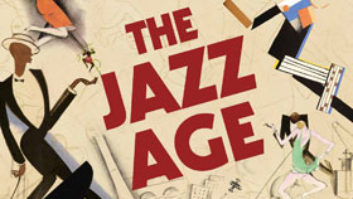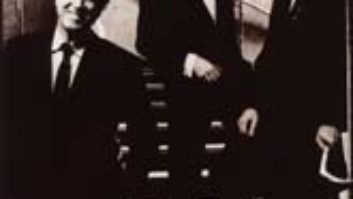
From L to R: Phil Manzanera, Bryan Ferry and Andy Mackay
Photo: Anton Corbijn
Nineteen eighty-two was a time when predictions of the death of album rock and the tandem ascendance of MTV and CHR (Contemporary Hits Radio format) seemed to be supported by a crush of video-ready pop songs such as “Der Kommissar,” “She Blinded Me With Science” and “Who Can It Be Now.” It was a time when some ’70s acts with any track record at all (who hadn’t faded under the pressure of new wave and punk) went to awkward lengths to keep up with the plastic futurism of Flock of Seagulls and the playfully disposable pop of Toni Basil.
Roxy Music didn’t have that problem. Many of the best from the new crop of arty pop bands from that era owed a lot to Roxy’s earlier incarnations, from the playfully quirky theatrical apparel to the emotionally detached, affected cool of some of their best music. Even though Roxy Music’s influence (along with David Bowie’s) could be spotted in some of the talent that arrived with the British and Australian Invasion of the ’80s, the band had already grown up and evolved into a sophisticated, finely tuned ensemble that was largely the vision of lead singer/songwriter Bryan Ferry.
Beginning with the transitional 1975 release Siren, through Manifesto (1979) and Flesh + Blood (1980), Roxy Music began moving away from the dense, artful chaos of earlier creative peaks (like Country Life and Stranded) and started fashioning a sleek, elegant sound that possessed an exotically atmospheric sensuality, culminating in their 1982 swan song, Avalon.
From the longing opener, “More Than This,” and the coolly funky “The Space Between,” to the aching beauty of “To Turn You On,” Avalon earned a reputation for being one of the most romantic records ever made in the rock era. It also became, over time, Roxy Music’s most commercially successful album, landing at the top reaches of the English charts and producing three hit singles: “More Than This,” “Take a Chance With Me” and the title track.
The album was recorded and mixed in 1981 and 1982 at Compass Point (Nassau, The Bahamas), the Power Station (New York City) and Roxy guitarist Phil Manzanera’s Gallery Studios (London). It was engineered by producer Rhett Davies and Bob Clearmountain.
When asked in 1982 about the concept of Avalon, Ferry responded, “I’ve often thought I should do an album where the songs are all bound together in the style of West Side Story, but it’s always seemed like too much bother to work that way. So instead, I have these 10 poems, or short stories, that could, with a bit more work, be fashioned into a novel.
“Avalon is part of the King Arthur legend and is a very romantic thing,” Ferry added. “When King Arthur dies, the Queens ferry him off to Avalon, which is sort of an enchanted island. It’s the ultimate romantic fantasy place.”
Regardless, the entire album sustains a cohesive mood that isn’t just a product of Ferry’s lyrical thematic vision. It was a product of the process that Davies and the band employed in laying down grooves and having players interact with them, and then shaping those performances in a way that would ultimately inspire Ferry to articulate his melodies and words.
“We were creating tracks back then,” Davies says. “We didn’t have the songs. The songs were virtually the last things to go on there. We were very much creating a musical atmosphere that we wanted the musicians to respond to.
“In those days, Bryan and Roxy would have a musician in for a day or two and they would want that musician to play on all the songs and see what came out of that,” Davies continues. “I would have to be able to throw the tracks up pretty quickly and they had to sound the same every time. Rather than spending half-an-hour putting the track up and then another half-an-hour getting the bass sound, we wanted to work fast. In the initial stage of throwing a track at somebody, it was always that first response that you got when someone was fresh that was very important. Then we would spend days and weeks agonizing over it and fiddling around with it,” he adds with a laugh. “But the initial process we wanted to keep fast.
“We kept everything and we would comp like crazy. We were looking for anything that fit, and if it added atmosphere and it worked, we used it — even little half-notes. When you hear the guitar parts soloed, they just don’t make sense until you put it all together and you realize that guitar part worked with the bass part, which fit in with the keyboard pad and it all created a balance. It’s a combination of things that makes that phrase work.”
One of Avalon‘s highlights was the dream-like title track, which opens up with shimmering guitar punctuations over a gently sensual groove, while Ferry sounds spent, yet hopeful, longing for release.
Had “Avalon” continued in the direction of its earlier stages of evolution, it would’ve been a much different song: “It was really fast, twice the tempo, even though it was the same chord sequence,” says Davies, “but it never really developed into anything. I can vaguely remember the rhythm box on there and the feeling that it was very pop tune — sounding, but [Ferry] couldn’t exactly get a handle on it in a way that fit the album.”
What became “Avalon” was originally penciled in as “New Scatter,” a name that referred to the process with which Ferry created lyrics at the time. “Bryan would lay down four or five scat vocals. We would spend quite a lot of time doing that, and we would actually comp the scat vocals as if they were final vocals with lyrics,” says Davies. “It might seem stupid that we were comping mumblings, but that is basically what we were doing. I think it gave Bryan a clue to the actual shape of the sound of the lyrics, be it an ‘e’ or an ‘o’ sound or whatever, so that they sounded right with the mood of the music. If you put the scat vocal tracks up and really listen to them next to the finished vocal, it wouldn’t sound that much different than the finished vocal. He was using identical shapes!
“Over the months, he would work on the verses and choruses and slowly get ideas on what the song was about,” Davies continues. “He would come in and say, ‘I think I’ve got a first verse’ and he would try it. Then he might come in later and say, ‘I think I have a second verse,’ or ‘I think I’ve got a chorus.’ It was pieced together, along with the rest of the music, over the period.”
While much of the album’s elements were recorded at Gallery Studio and Compass Point, “Avalon” came about one weekend in a flush of last-minute inspiration as the band was getting into mix mode with Clearmountain at the Power Station. Suddenly, Ferry visualized the essence of “New Scatter” as a much slower song and came up with the new version.
“Bob had previously been booked over the weekend on another project,” says Davies. “We were away from home and at the Power Station anyway, so Bryan said, ‘Let’s go in there over the weekend,’ and we basically re-cut the entire thing, from start to finish, over the weekend. It was the last track that we finished for the record.”
Ferry had stayed up that Saturday night and composed what would be the lyrics to “Avalon.” Then, happenstance would provide “Avalon” with one of its most memorable elements: the interpretive vocal contributions of Yanick Etienne. Sunday was usually a down day at the Power Station, so the studio would let local Haitian bands come in to do demos when there wasn’t much happening. It was then that Davies and Ferry, on a coffee break in the hallway, heard Etienne singing.
“Bryan and I could hear this girl from the Haitian band next door singing, and we thought, ‘Wow! What a voice! We’ve got to get her singing some backing vocals on “Avalon.”’ That was Yanick Etienne, who didn’t speak a word of English. She came in with her boyfriend/manager and we described to him what we wanted and she sort of sang the choruses and the [word] ‘Avalon’ — the great sound that is on there. Then we said, ‘Can she try and do something free at the end?’ and we ran the end of the track and she did absolutely nothing. So I said, ‘No, we want her to sing anything that she would want to sing, totally free.’ So the second time we ran the tape, she sang exactly what you hear on the record at the end.
“Bryan then went straight out and re-sang his vocal properly, because he was so inspired by Yanick’s singing. I remember Bryan’s manager walked in the room and Bryan was just finishing his vocal. We were doing the playback and I’d never seen the look on his eyes before. He went, ‘Jesus f****** Christ! That is incredible!’ Well, we knew it was a really high point of the evening. I remember going, ‘Wow! We have really created something special here.’ That is how I felt. Then we mixed it the next day with Bob.
“It was one of those turnaround things, where the original track was just about to be thrown in the can. And then suddenly, we did a completely different version of the song that just made the record for me,” Davies concludes. “I thought, ‘That’s it. That completes the record!’ I remember we had dinner a couple nights later, and I asked Bryan, ‘What are you going to call the album?’ and he said, ‘I’m going to call it Avalon,’ and I thought, ‘Yeah. Of course.’”







